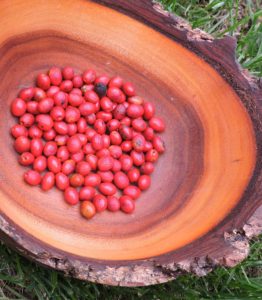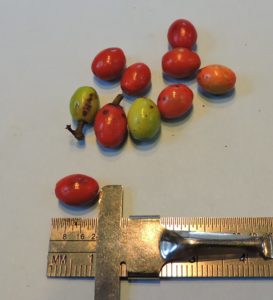Name: Common Spicebush
Botanical Name: Lindera benzoin
Form: shrub
Parts Used: fruit
Citation: Guenther, K. (2017, January 12) Spicebush as wildlife food [Web log post.] Retrieved: readers supply the date, from http://wildfoods4wildlife.com
Getting Started
Spicebush is a fun plant to know about—a living scratch and sniff! The spiciness of this plant is one of its identifiers. Scratch a twig with your fingernail or squeeze a berry between your fingers and you will smell the lemony tartness exuding out of the plant.
A variety of birds eat this fruit, especially thrushes—including robins, of course. Wood thrush and veeries especially favor the fruit. It ranks #41 on our Favorite Fruits list.
Lauraceae (Laural Family)
Lindera (Spicebush Genus)
|
Common name |
Virginia Lindera Species | Origin | Rare Plant Status |
| northern spicebush | L. benzoin | native | yes, in some states (not Virginia) |
| southern spicebush | L. melissifolia | native | yes, in some states (not Virginia) |
| bog spicebush | L. subcoriacea | native | yes, in some states (not Virginia) |

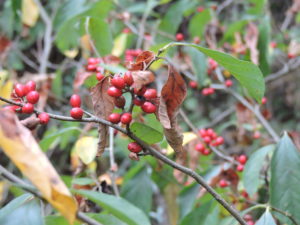
Key Features to Look for
In addition to the identification guide of your choice, here are a couple of features you should see on this shrub:
- Whole plant is noticeably spicy smelling—crushed berries, leaves or scratched twigs
- Bright red, oblong, shiny red berries with stems
- Leaves alternate, smooth leaf edges (entire)
- Shrub is heavily branched, light gray, relatively smooth bark
- Small cluster of yellow flowers like miniature pompoms, before leaves come out
- Multiple trunks
- Shrub is about 1-1/2 times as tall as a human
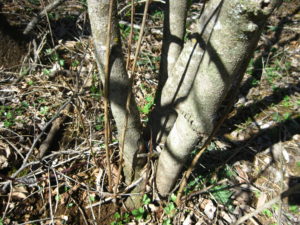
Risks
None indicated.
About this Species
In western Virginia, starting mid-March, I look for the blooms on spicebush shrubs which will stand out against the still leafless woods, making it easy to go find and identify where my fall spicebush harvest will come from. The bloom really helps narrow the options, because from at a glance the yellow flowers look like little pompoms glued onto the branches before the shrub leafs out. In some areas, the majority of understory is made up of spicebush thickets.
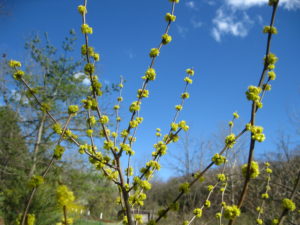
Spicebush is dioecious, meaning some plants are male and some are female. So not every flowering shrub you find will have berries in the fall. Most stands of spicebush will have a mix of male and female plants in fairly close proximity to each other, but if you want to you can teach yourself how to sex a spicebush shrub based on the flower to determine exactly which shrubs will be the autumn berry-bearers.
Flower Description: Spicebush flowers in little flower clusters of 2-5 flowers. From a distance they appear as little yellow “pompoms” along the twigs before the leaves emerge. The shrubs often grow in stands together.
You may need a hand lens or telephoto on a camera to help you see the small male and female parts of the flowers. The reason to determine which shrubs are female is so you know which shrubs to return to later to collect the berries!
Male shrubs produce flowers with 9 stamens around a concave empty center. Female shrubs produce flowers with a “bowling pin” shaped center pistil that emerges from the center of the flower. If you are looking at a small stand of spicebush in bloom, the shrub with the smaller “pompoms” is likely to be the female to examine for the pistils. Both male and female flowers have 6 short yellow sepals which look like petals. Here, Native Plant Society of New Jersey members helped teach me the difference between male and female flowers. Thanks to Millie Ling and her husband for documenting this so well!
Male vs. Female Spicebush Flowers
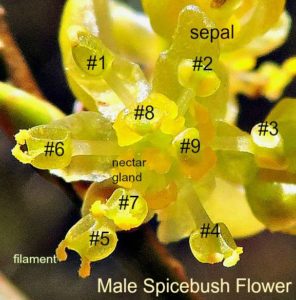
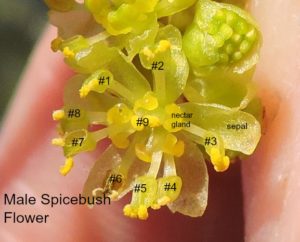
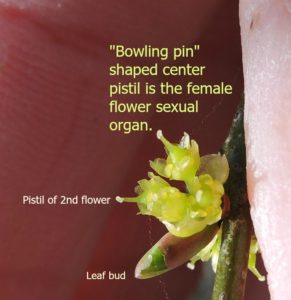
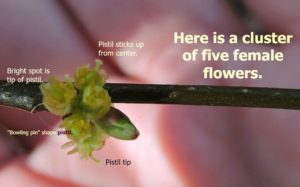
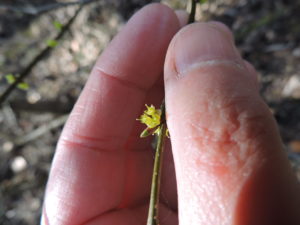
Leaf Description: Leaves alternate up the twig and the edges of the leaf are continuous or smooth (entire). Often the leaf is widest towards the tip of the leaf. (Weakley, Ludwig and Townsend, 2012)
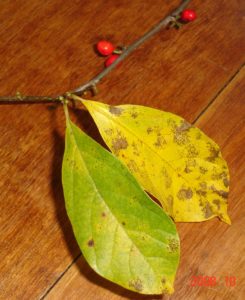
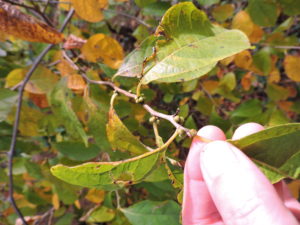
Seed/ Fruit Size: The single seeded berry—a drupe—is bright red, oblong and shiny, and when crushed in your fingers smells lemony spicy. Berries average around 1/4 inch (6 mm) wide by 7/16 inch (1 cm) long. This fruit is not very fleshy–the seed is large as in many wild fruits–but is high in fats.
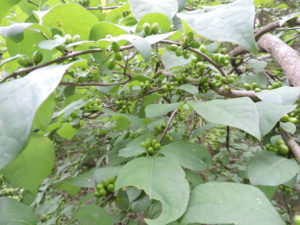
Harvesting
| Jan | Feb | Mar | Apr | May | Jun | Jul | Aug | Sep | Oct | Nov | Dec | ||||||||||||||
|---|---|---|---|---|---|---|---|---|---|---|---|---|---|---|---|---|---|---|---|---|---|---|---|---|---|
| winter | winter | late winter | early spring | spring | late spring | early summer | summer | late summer | early fall | fall | late fall | ||||||||||||||
| fruit | x | x | x | x | |||||||||||||||||||||
Does this lend itself as a good enrichment item? Possibly, if for some reason the whole shrub needs removal during the harvest season, branches with fruit attached can gently be installed in enclosures without knocking the fruits off. Or minor selective pruning of branches loaded with berries can be installed. Because the shrub is not large, it will not tolerate a lot of pruning.
Nutrition: High in calorie-rich fats.
Harvesting Fruit
Once berries turn bright red, pick individually by hand.
How to Store Prepared Fruit:
Commercial berry containers are great for storing fruit because the rigid plastic keeps fruit from getting crushed and they also have small holes in them which control the humidity in the container. This slows the fruit from drying out too quickly, but allows air circulation to reduce molding.
Spicebush berries keep well in re-used commercial berry containers in the refrigerator for one to two weeks.
It is ideal to use this fruit fresh, so if at all possible, use them fresh. Frozen fruits just come out dark and mushy, but if you really need to freeze them you can, knowing that the texture will be greatly compromised upon thawing. Nutrients will be preserved. Spread berries in a single layer on a cookie sheet and place in freezer for 1 day. Once frozen, repackage them into zipping freezer baggies (3 mils or thicker) or glass jars to keep them from drying out, remove as much air as possible from the baggie, label and store in freezer until needed—no more than 1 year. Avoid freezing, thawing and refreezing as might happen in a door of a freezer.
See more detailed instructions under Storing Fruit.
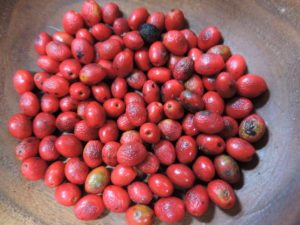
Feed Spicebush fruits to:
NO RECORDS FOUND
Book References:
Martin, A.C., Zim, H.S., Nelson, A.L. (1951). American Wildlife and Plants: A Guide to Wildlife Food Habits. New York: Dover Publications.
Scott, M. (2013). Songbird Diet Index. National Wildlife Rehabilitators Association, St. Cloud, MN.
Weakly, A.S., Ludwig, J.C., & Townsend, J.F. (2012) Flora of Virginia. Fort Worth, Texas: Botanical Research Institute of Texas Press.
On-line References:
Ling, H., & Ling, M. (date unknown). Lindera benzoin– Spicebush [Web log post]. Retrieved 3/24/16 from http://www.npsnj.org/photo_galleries/photo_pages/lindera_benzoin.html. USDA, NRCS. 2015. The PLANTS Database (http://plants.usda.gov, 4 January 2016). National Plant Data Team, Greensboro, NC 27401-4901 USA.
Virginia Botanical Associates. (Accessed January 2016). Digital Atlas of the Virginia Flora (http://www.vaplantatlas.org). c/o Virginia Botanical Associates, Blacksburg.

